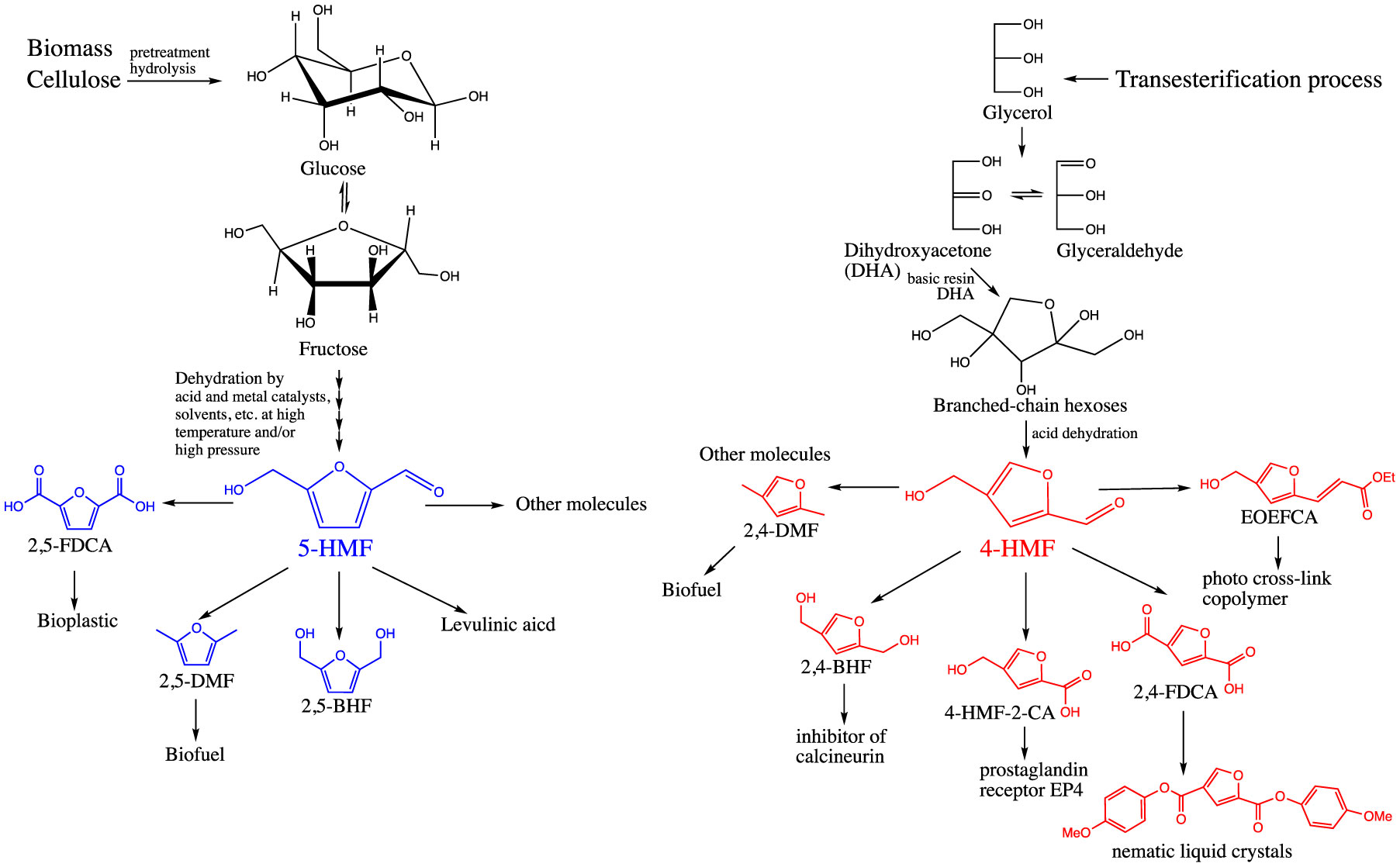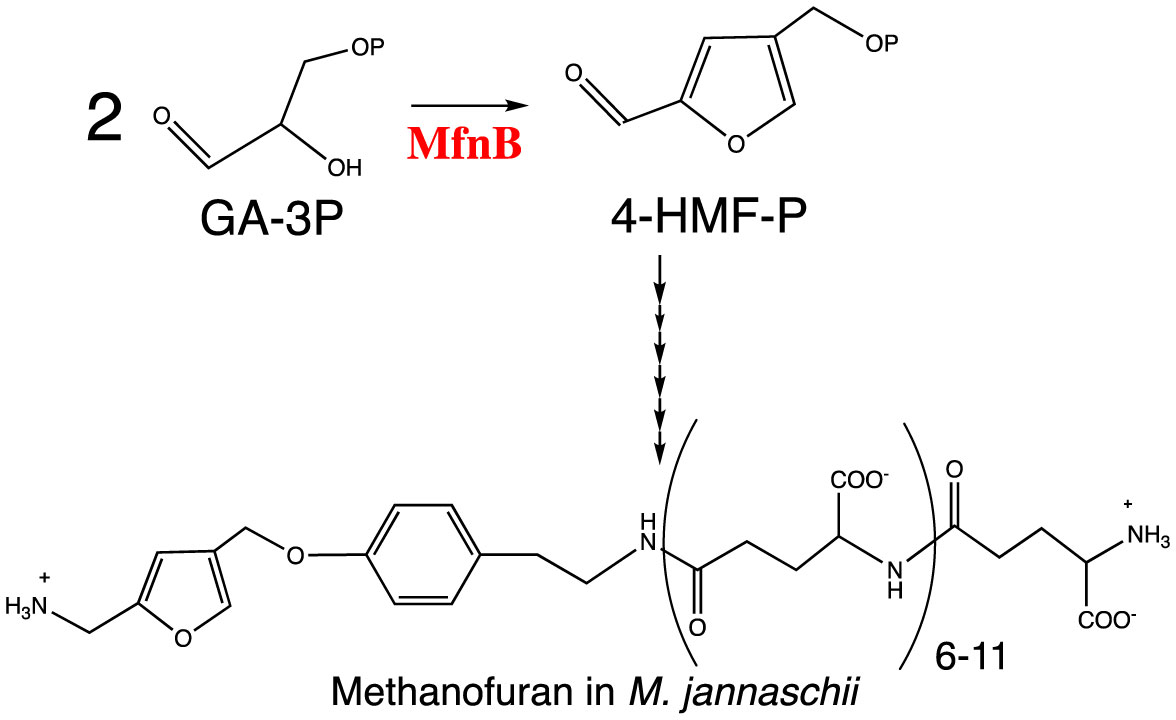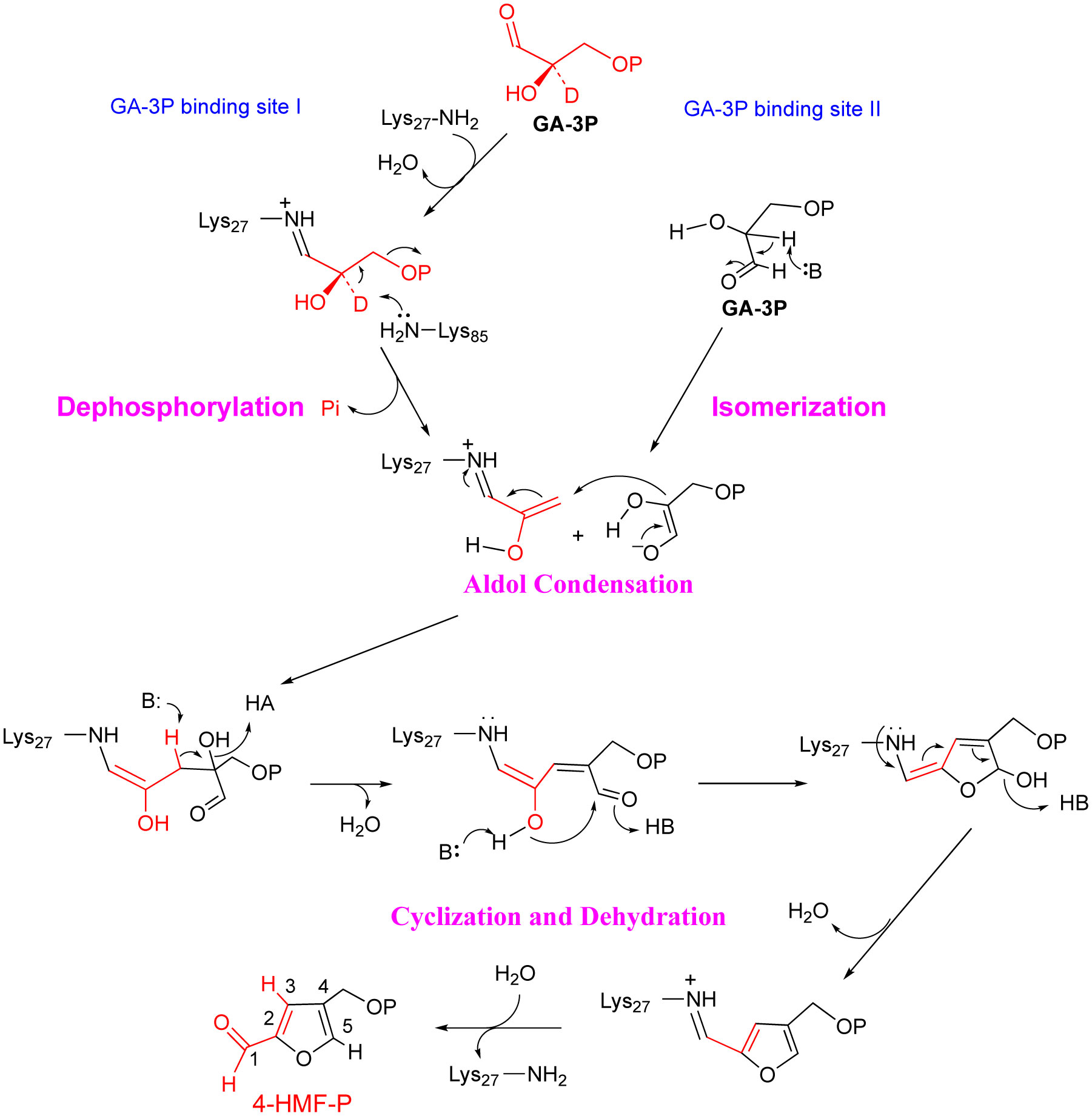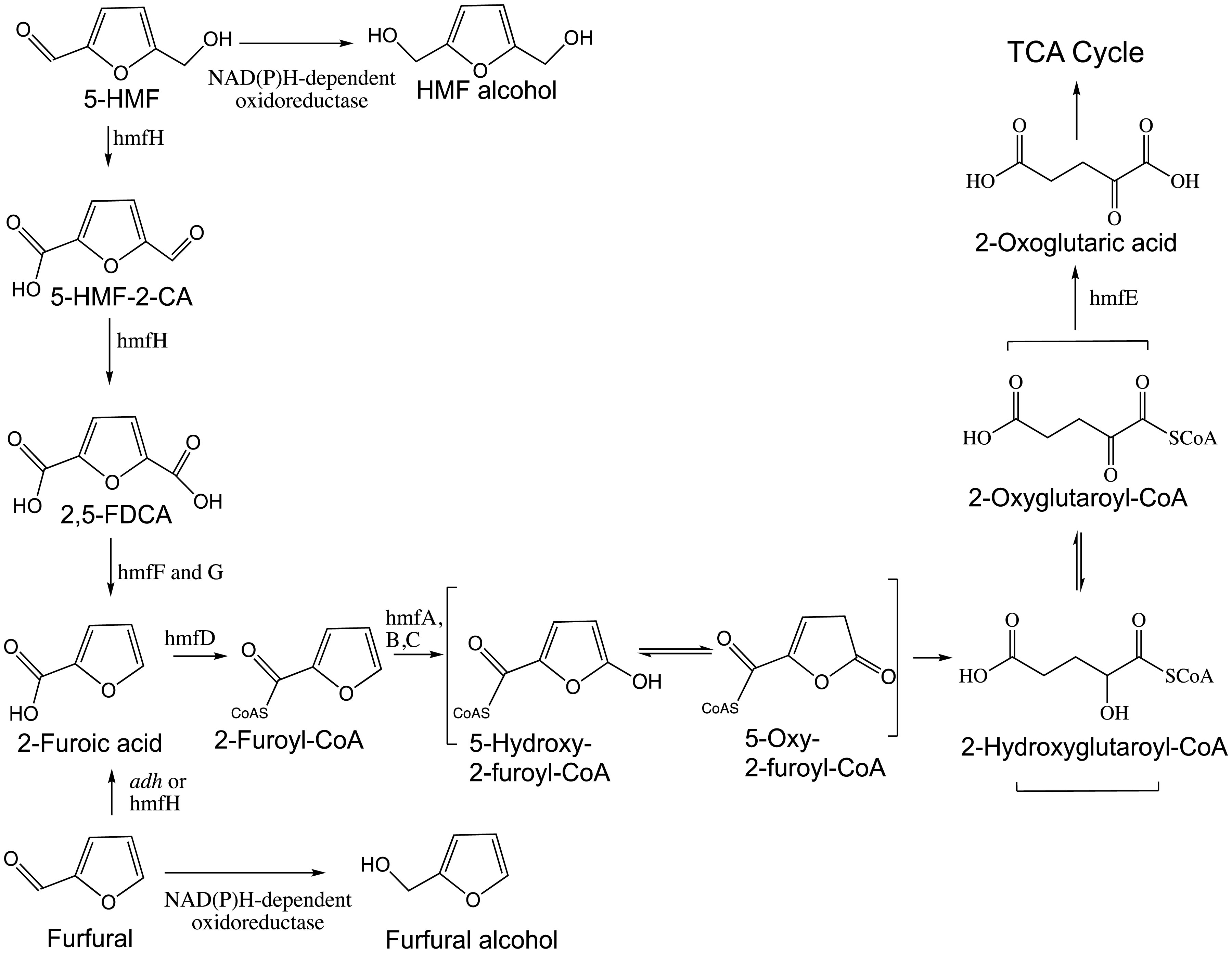Biorefinery is increasingly embraced as an environmentally friendly approach that has the potential to shift current petroleum-based chemical and material manufacture to renewable sources. Furanic compounds, particularly hydroxymethylfurfurals (HMFs) are platform chemicals, from which a variety of value-added chemicals can be derived. Their biomanufacture and biodegradation therefore will have a large impact. Here, we first review the potential industrial production of 4-HMF and 5-HMF, then we summarize the known microbial biosynthesis and biodegradation pathways of furanic compounds with emphasis on the enzymes in each pathway. We especially focus on the structure, function and catalytic mechanism of MfnB (4-(hydroxymethyl)-2-furancarboxyaldehyde-phosphate synthase) and hmfH (HMF oxidase), which catalyze the formation of phosphorylated 4-HMF and the oxidation of 5-HMF to furandicarboxylic acid (2,5-FDCA), respectively. Understanding the structure-function relationship of these enzymes will provide important insights in enzyme engineering, which eventually will find industry applications in mass-production of biobased polymers and other bulk chemicals in future.
1.
Introduction
Graphene nanoribbon (GNR) is a narrow strip of the patterned graphene sheet that has gained considerable research interest for its distinct electrical, thermal, structural, magnetic, and mechanical properties [1,2,3,4,5,6,7,8,9,10,11]. The properties like, linear E-k relationship, long mean free path (MFP), superior mobility, ideally negative temperature coefficient of resistance, and a width-dependent transport gap have made GNR a stronger alternative to the conventional copper for nano-interconnect applications [12,13]. Although GNR has very high carrier mobility [14], it is limited by different scattering mechanisms. Depending on the geometry, GNRs exhibit metallic or semiconducting property [15,16]. The transverse width of GNRs should be substantially smaller than that of the longitudinal length [17,18]. Depending upon the position of Carbon atoms at the edges, GNRs are classified as armchair and zigzag nanoribbons as depicted in Figure 1a, b. The difference in orientation at these edges of GNRs is 30° [18,19,20]. Subsequently, no contribution from GNR has been observed to energy states near the Fermi level of Carbon atoms as hydrogen atoms passivize the edge of the GNRs [19,20]. N is illustrated in Figure 1 as the number of dimers for armchair GNR as well as zigzag lines in ZZ-GNRs [12]. The width, w of the GNR has a direct relationship with the integer N, which is represented in Figure 1a, where it has been presented that, width and length of the unit cell of armchair GNRs are $ w = (N+1)a/2 $ w and $ {a}_{T} = \sqrt{3}a $. However, in the case of ZZ-GNR, these are, w and a, w and a ($ w = a\sqrt{3}+\sqrt{3{N}_{a}/2} $) respectively, which has been shown in Figure 1b. The value of N is $ (3p+2) $ when an armchair GNR possesses the metallic property, and it is 3p or $ (3p+1) $, the nature is semiconducting [21]. It should be noted that p has been assumed to be an integer at this point (p = 1, 2, 3…).
The bandgap shrinks with the increase of the width of the semiconducting GNR, and the metallic GNR has a large value of N [12]. The ZZ-GNR's Brillouin zone has partially flat bands due to their edge states and consequently shows zero bandgap with metallic behavior [19,20,22]. Furthermore, it is build up with three kinds of arrangements of carbon atoms; consequently, a significant difference in heat transfer capability is observed [23]. Therefore, the ZZ-metallic GNRs have attracted wide attention among researchers in the field of on-chip interconnect design [12,19,24].
The intercalation is a process of implanting molecules or ions between the large van der Waals gap of GNR layers. It has been reported in the literature that intercalation doping in bulk material shows a significant distinction from the layered materials like GNR [25,26]. Subsequently, intercalation doping in layered material upshots significant improvement in the device and interconnect-based applications [27,28,29,30,31]. Intercalation doping has been proved as a very powerful way to tune the attributes of MLGNRs for few reasons like, (a) the associated changes of the material properties are irreversible, (b) through this process, highest possible doping can be achieved, and (c) the amount of intercalation is controllable, and periodically run-time control has been achieved through electrochemical voltage.
With the intercalation doping, both the in-plane and interlayer (c-axis) resistances of MLGNR have been improved. Major improvement in Fermi energy, mobility, and mean free path has been achieved through Arsenic Pentafluoride (AsF5-), Lithium (Li-), Ferric Chloride (FeCl3), and Molybdenum Pentachloride (MoCl5) intercalation doping. Lithium (Li-) intercalated ultrathin graphite structure is fabricated, and improvement in Fermi level and in-plane conductivity has been experimentally observed [30]. The reported values of inter-layer conductivity (σc) of pristine and intercalation doped graphene are presented in the literature [25,26,28,29,32] as displayed in Table 1.
The rest of the article is organized as follows. Section works on modelling and analysis of GNR based interconnects presents a detailed review on modeling and analysis of GNR based interconnects. The practical works on GNR are presented in section practical works on GNR, followed by section conclusions.
2.
Works on modelling and analysis of GNR based interconnects
A number of research articles have been published which demonstrate the performance of GNR interconnect in nano-scale high-speed CMOS-based design. Naeemi and Meindl [33] proposed a physics-based conductance model for graphene nanoribbon (GNR) interconnect for the first time. They also proposed a charge transport model of zigzag and armchair graphene nanoribbons [34]. Murali et al. have proposed a temperature-aware resistivity model of graphene nanoribbon interconnect [35]. Further, Naeemi and Meindl [36] have proposed a complete compact physics-based circuit model for GNR interconnect with an accurate calculation of the number of conduction channels (Nch) in a single layer GNR (SLGNR) using the close form approximation method. The equivalent single-conductor (ESC) model of MLGNR interconnect is illustrated in Figure 2 [13].
Nasiri et al. proposed a compact formula to calculate temperature aware number of conduction channels of graphene nanoribbons with different Fermi energy [37]. However, this approach limits the computation for a given temperature and Fermi energy only. Figure 3 shows the design route of the MLGNR as an on-chip interconnect.
In [28], Banerjee et al. have proposed the conductance model of GNR with tight-binding approximation and obtained a linear E-k relationship using Landauer formalism. Here, the delay analysis in GNR interconnects has been presented as well as the performance comparison with other interconnect materials, such as copper (Cu), tungsten (W), and CNT, has been performed. Nasiri et al. have presented stability analysis in GNR interconnects [38]. The relative stability of multilayer GNR (MLGNR) interconnects is analyzed using the Nyquist stability criterion. Their analysis shows that by increasing the length and width, MLGNR interconnects become more stable. The crosstalk stability analysis using multilayer GNR interconnects is reported in [39]. Ramesh Kumar et al. have reported the delay, and stability analysis of multilayer GNR and multi-walled CNT interconnects [40].
Kumar et al. first proposed different contact-based modeling (top-contact and side-contact) of graphene nanoribbon-based interconnect [41]. Following the route, Nisad et al. in [42] proposed a 2D resistive model for top-contact and side-contact MLGNR interconnects. It is observed that the side-contact MLGNR (SC-MLGNR) performs better than top-contact MLGNR (TC-MLGNR) in terms of delay, power-delay product (PDP), energy-delay product (EDP), etc. reported in [40,41,42,43]. But from the fabrication point of view, the TC-MLGNR is much better than SC-MLGNR reported in [41,42]. Subsequently, to improve the performance of TC-MLGNR, intercalation becomes important. The conductance modeling of intercalation doped TC-MLGNR has been presented in [22]. Intercalation doping with Arsenic pentafluoride (AsF5) in MLGNRs has been carried out by Xu et al., and substantial improvement in Fermi level consequently MFP and been observed [44].
A self-heating model has been proposed by Jiang et al. [45] on Lithium (Li-) and Ferric chloride (FeCl3-) intercalation doped ultra-thin graphite arrangement has been fabricated as TC- interconnect and the improvement in Fermi level, and the in-plane conductivity has been experimentally observed. Das et al. proposed an electro-thermal RF model [46,47] for intercalation doped TC- as well as SC-MLGNR considering the integrated effect of distributed interconnect system based on the thermophysical property of multilayer GNR studied in the literature [48,49,50,51]. They have demonstrated superior RF performance of intercalation doped TC-MLGNR interconnect as compared to its pristine counterpart for different chip operating temperatures. Rakheja et al. [52] have compared the energy dissipation, and overall performance of graphene spin interconnects in a non-local spin-torque (NLST) circuit against the conventional CMOS-based circuit. They also reported the prospects of graphene-based interconnect that could be the replacement of copper in future microchips. The spin injection probability of electron in graphene wires has been further explored by them in [53]. The improvement of carrier transport with the help of the selective hydrogenation mechanism of edges for sub-30 nm graphene nanoribbons (GNRs) has been reported [54]. After improvement of the edges roughness, the GNRs exhibit improved transport properties. The carrier mobility has been improved up to 50% when the carrier density is cm−2 at room temperature.
Pan et al. [55] reported the advantage of GNR interconnect over the traditional Cu-based nano-interconnect for next-generation VLSI interconnect. They have designed a 32-bit adder using MLGNR interconnect and observed a 70% improvement in EDP. They have also demonstrated the design of the ARM processor using MLGNR interconnect and achieved 22% and 15% improvement in EDP and clock frequency, respectively. It should be noted that the benefits observed in ARM processors are highly dependent on the quality, such as the MFP and the edge roughness of the GNR.
The simultaneous switching noise (SSN) and IR-drop analysis for graphene nanoribbon-based power distribution network reported by Das et al. [56]. This paper reports the peak SSN in Cu-based interconnects 41–23% larger than that in GNR. Consequently, the peak IR-drop in GNR is 38–34% lesser than that of traditional copper wires. The propagation delay is highly affected due to SSN and IR-drop. GNR shows up to 64.49% lesser impact in the SSN generated delay in comparison with the Cu-based power networks. The reduced thickness model of MLGNR interconnect has been proposed by Bhattacharya et al. [57]. It has been demonstrated that keeping the width constant, reduced thickness of MLGNR has a lesser impact on crosstalk delay and overshoot/undershoot. The IR-drop induced temperature aware delay fault model of CNT and GNR based power distribution networks is proposed by Das et al. and Bhattacharya et al. [58,59]. It has been observed in these works that the delay faults can be reduced using CNT as well as GNR based power interconnects at longer lengths as compared to the conventional Cu-based power interconnects. The crosstalk and gate oxide reliability analysis in GNR interconnects have been investigated by Sahoo et al. [60] and Das et al. [61]. It has been observed that electric field acceleration rises significantly at a higher temperature. This set a substantial impact on gate oxide reliability on MLGNR driven interconnect system. This thermal impact of gate oxide reliability has been reported by Das et al. [62].
The contact resistance-related issues in GNR based interconnect is very crucial in sub-nanometer technology. It may be top-contact or side-contact. The top-contact resistance for multi-layered GNR interconnect is ~4.3 kΩ reported in [41]. Leong et al. [63] reported the graphene-based devices with nickel-etched-graphene contacts, which shows considerably low contact resistance.
Signal transmission and integrity analysis on GNR based interconnect reported by Zhao et al. [64]. Signal integrity analysis of single and multi-layered GNR interconnects has been performed based on their circuit equivalent models, with crosstalk effects characterized theoretically. It has been concluded in their work that longer SLGNR interconnect with larger width results in higher crosstalk noise than that of MLGNR or Cu-based interconnects. Cui et al. [65] have analyzed signal transmission characteristics in multilayer GNR (MLGNR) interconnects for 22 nm and 14 nm technology nodes. An ESC model has been derived, and transient response is studied in their work. Another signal transmission analysis along GNR interconnects has been reported by Xu et al. [66]. Sarkar et al. have reported the UHF behavior of GNR based interconnects. They have proposed a numerical model of GNR as an on-chip interconnect to calculate the surface impedance with anomalous skin effect in high-frequency using linear dispersion relation of graphene [67,68]. Chen and Fratini et al. [69,70] have reported the distress of low-bias resistivity due to phonon-based scattering (e.g., acoustic phonon scattering (AP) and remote interfacial phonon (RIP)) with temperature. These works imprinted a significant impact on temperature-dependent models and circuit analysis of GNR as an on-chip interconnect [37,45,47,59,62].
3.
Practical works on GNR
The world's first graphene-based integrated circuit (IC) was developed by IBM in the year of 2011. An article on graphene-based IC design by the IBM research group is reported by Lin et al. [3]. T. J. Watson Research Center (Microelectronics Research Laboratory) and AMO Nanoelectronics group had demonstrated the possibility of creating the graphene-based transistor [71]; this evolutionary research took the technology a step further by binding the transistor and other electronics on a single chip to build a full-fledged integrated circuit. In this work, the wafer-scaled graphene-based circuit has been reported, where graphene channel-based FET, interconnect, and inductor, were monolithically integrated on a single SiC wafer. The IC was operated as a broadband RF-mixer operative up to 10 GHz frequency range. The graphene-based system exhibited outstanding thermal stability between 300 and 400 K chip operating temperature. This integration gives an inference to a platform created by Meyer et al. in 2007 with suspended graphene [72]. The pioneering work done by IBM [3] created a perpetual impact on future research on graphene-based technology for integrated circuit applications.
Heinz and co-workers modeled as well as fabricated the monolayer graphene resonator on SiO2 substrate to demonstrate that graphene can transduce the motion of profound resonant circuit with minimal damping [73], the comprehensive experimental arrangement of the resonator along with schematics, circuit diagram, and SEM image are portrayed in Figure 4. This study demonstrated the superiority of graphene over CNT, evaluating the reproducible electrical properties and a larger surface area for capturing the incoming mass flux. In this work, monolayer graphene flakes have been fabricated on locating on Si/SiO2. Subsequently, atomically precise bottom-up fabrication of GNRs on a gold substrate has been demonstrated by Fasel and his team [74], which formed GNRs. This method produces GNRs with well-controlled widths and various shapes. The controllable preparation of graphene has been pioneered by Müllen and co-workers [75,76] with bottom-up organic synthesis so that it can be produced on a large scale as an on-chip VLSI interconnect. On top of that, recently, Fischer and his team demonstrated an ingenious method in Science [77] to produce metallic GNRs based on the atomically precise bottom-up synthesis.
Chen et al. [78] fabricated graphene-based interconnects with CMOS-based mixed-signal application, as shown in Figure 5. The graphene layers have been moved to the substrate with the help of the poly-methyl-methacrylate (PMMA) assisted method, which has been demonstrated through the progression flow chart of Figure 5a. Subsequently, graphene-based interconnects and Ti-based via have been developed with CMOS-compatible fabrication methodology. Cr/Au has been used as the contact metal of graphene-based interconnects, as shown in Figure 5b. An optical image has been captured demonstrating the graphene-based interconnects on the top layer of the ring oscillator array in CMOS based process (Figure 5c, d).
Han et al. [79] of the IBM research group reported the graphene-based on-chip RF receiver circuit, which has been integrated with a high-performance 3-stage RF amplifier, filter, and down-converter mixer module. This work revealed the use of the graphene-based system for high-end RF communication of 4.3 GHz bandwidth. Among a number of methods which have been reported to obtain intercalation doping in MLGNR, specifically chemical and electro-chemical intercalation method have been subjugated in practical implementation. Each of them is further subdivided into the categories depending upon the base of the intercalation species. As an example, when the chemical vapor transport method has been adopted for the chemical intercalation method, it is categorized as gas-phase intercalation; on the other hand, wet chemical methods are classified as liquid phase intercalation. Solid-state electrolyte intercalation and liquid electrolyte intercalation are the categories of electro-chemical intercalation doping. Intermittently molten metal (salt) intercalation doping (Li in few-layer graphene) has been reported in experimental reports [25,80], whereas Crommie et al. demonstrated intercalation of C60 into a single fold in graphene in [81]. Figure 6 provides a summary of the field of intercalation doping of 2D materials.
Recently, Jiang et al. demonstrated the CVD-grown and FeCl3- intercalation-doped MLGNR for superior interconnect application [30]. MLGNR layer was first transferred to the Si- substrate. Subsequently, the Ni/Au-based alloy contacts were built for the measurement of resistivity, as shown in the flow of Figure 7. FeCl3 intercalation doping was carried out at 633 K and ~1.4 atmospheric pressure for 10 h in an Argon atmosphere, as shown in Figure 7i, j [30].
4.
Conclusion
A detailed literature review on graphene-based nano-interconnects is presented in this article. At first, the modeling works on GNR interconnects with different contact models are discussed. Several analysis works are reviewed thoroughly for the applicability of GNR as a nano-interconnect for future generation VLSI circuits. Next, the GNR growth technologies are presented along with different process technology. As prospective mend of nano-interconnect application, intercalation doped GNR has been emphasized and discussed with its experimental and model development outline in this review. In a nutshell, this article provides a scientific survey in favor of pristine and intercalation doped layered graphene nanoribbons as a potential candidate among nano-interconnects of future integrated circuit-based applications.
Acknowledgments
This work has been partially supported by SMDP-C2SD, DeitY, MCIT, India.
Conflict of interest
The authors declare no conflict of interest.










 DownLoad:
DownLoad:














